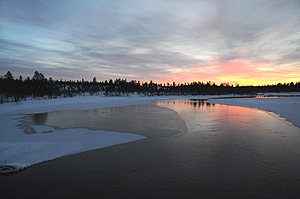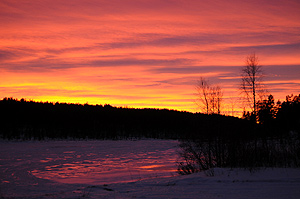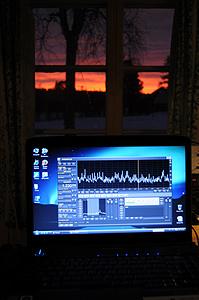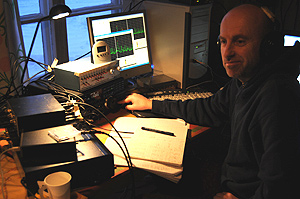|
LEM271 DXpedition to Lemmenjoki
December 25, 2008 - January
3, 2009
by Mika
Mäkeläinen
After two hectic years of working
as correspondent for YLE in Washington, I finally
found time for a DXpedition across the Atlantic,
so you can imagine my excitement - I just couldn't
wait to get to Lemmenjoki again. After flying to
Helsinki, I first spent a week running errands and
catching up with friends and relatives. We celebrated
Christmas with family in Tampere on Christmas Eve,
as our tradition is, and on Christmas Day I headed
north.

Kettukoski in Inari, close to Lemmenjoki |
My jetlagged internal clock was already way off
any nearby time zone, so rather than just lay awake
in the middle of the night, I packed my wife's Chrysler
Voyager and began driving to Lapland at 4:30 a.m.
on December 25. This was probably the most quiet
time of the year on the road. During the first 100
kilometers from Tampere to Jyväskylä I
saw only two other cars, although this is one of
the main arteries leading north. Weather conditions
were pretty good, and so I drove 520 km (325 miles)
without stopping before refueling myself and the
minivan at Autokeidas ("Car oasis") in
Ii - yes, this shorty is the real name of the place,
north of Oulu. Driving to the next stop Kittilä
was a pleasure as there was some daylight much of
the way. I finally arrived in Lemmenjoki around
7 p.m. in the evening. Not all reindeer seemed to
be assisting Santa Claus, as I saw many on the roads
of Lapland.
Just before the DXpedition I bought the Italian-made
Perseus receiver which is capable of recording the
entire mediumwave band. I knew this would change
the very nature of DXpeditioning, taking SDR receivers
to yet another level, but unlike some others, I
view this more as an opportunity than a threat.
Perseus turned out to be quite a time machine, enabling
me to focus on monitoring subtle changes in conditions,
while postponing the identification of individual
stations to some distant point in the future, when
I would be able to actually listen to the thousands
of hours of recordings. Of course, with this amount
of recordings, it is impossible to listen to even
most of them, and so your DX instincts come to play
when determining what to concentrate on.

Polar night at Lake Kuivajärvi, just outside
the Lemmenjoki cabin. |
Perseus required a pretty powerful computer, so
I needed to buy one more laptop, which I sold to
Jari after the DXpedition, as I probably wouldn't
need one in about a year. In addition to the Perseus,
I had two SDR-14 receivers with laptops, so tables
in Lemmenjoki were covered more by computers than
receivers, and the floor was littered with 1TB hard
drives. Just putting it all together and trying
to figure out various software-related problems
took many hours, and even later on, the computers
tended to crash occasionally. Playing with antennas
occasionally crashed Perseus, perhaps because of
some electric spike, and as can be expected, this
usually happened just before the top of the hour.
However, I don't worry about the possible missed
catches, because in any case I already have much
more recordings than I can handle. Jari was equally
well-equipped with a total of four SDR-14 receivers.
The first day was partly spent on interference-management.
I had hunted for spare power supplies to get rid
of a newly discovered local interference source
in Lemmenjoki and had it eliminated. A much more
distant interference source was digital hash caused
by IBOC, the digital "HD Radio" system
used in North America. IBOC was a growing nuisance,
effectively wiping out many weak stations. Unfortunately
there's not much we can do about it, other than
hope that the broadcasting industry will eventually
come to realize that IBOC is technically flawed,
as well as a marketing disaster, and overall a huge
waste of money. Not that DRM in Europe would be
much better, and causes equally severe interference
on the European AM dial. Fortunately there are still
relatively few DRM stations on the air.
Over the course of the DXpedition, the few daylight
hours were partially used to check antennas, which
were mostly rebuilt in 2007 and were in great shape.
One of these new antennas points at 319 degrees,
and was normally the most effective wire for North
American stations.

Nerd aesthetics: Screenshot of Perseus software
with late afternoon daylight in the background
|
Honoring the utilitarian tradition of Lemmenjoki
DXpeditions, this was not a culinary expedition.
Anything that comes in a can and can be microwaved
and consumed wasting minimal time is ideal, but
some delicacies are worth mentioning. Exposed as
I was to the North, I was powered by Sarah Palin
inspired moose sandwiches (no, we didn't shoot the
moose from a helicopter), salmon, bear paté,
wood grouse, cloudberries and other Arctic delicacies.
Weather changed from one extreme to another; first
several days around and above freezing point, which
is rare on these latitudes, then a fierce blizzard
that doubled the snow cover, followed by freezing
temperatures of -20 degrees.
On arrival, space weather conditions were quiet,
but reception conditions were only mediocre, and
frankly, remained quite boring and predictable for
several days. Later on, a recurring coronal hole
arrived as expected on New Year's Eve, and shifted
conditions, but didn't bring about any major outburst
of signals from some specific direction. However,
signal levels from all directions improved.
Jari Ruohomäki, who joined me also on my two
previous end-of-year DXpeditions (see reports of
LEM239 and LEM220)
arrived two days later on the evening of December
27, and this is when the real action began. As it
was the last week of the year, there were many other
DXers in action around the Nordic countries, and
comparing our results especially to those in Parkalompolo
in Sweden (see PAX80
DXpedition report in MS Word format) gives an
interesting look at how big a difference a small
distance (200 km southwest) can make. Both crews
were equipped with the latest in SDR technology,
so the logs pretty well reflect what was audible
at any given time.
Compared to previous DXpeditions at the same time
of the year, LEM271 was probably below average.
In the following you can see a table of solar indices
during the DXpedition, and a more detailed day-by-day
review of conditions:
| Date |
Solar
flux at Earth |
Sunspot
number |
Planetary
A index |
K
indices (3-hour intervals) |
Min-max
solar wind speed (km/sec) |
Number
of flares (events) |
| STAR |
NO
AA |
STAR |
NO
AA |
Daily
low - high |
Planetary |
Boulder |
C |
M |
X |
| 24.12.2008 |
69.4 |
0 |
0 |
5.4 |
5 |
3-12 |
23121111 |
23232211 |
450-546 |
|
|
|
| 25.12.2008 |
69.3 |
0 |
0 |
3.3 |
3 |
0-7 |
00012111 |
00022221 |
436-494 |
|
|
|
| 26.12.2008 |
69.2 |
0 |
0 |
0.6 |
1 |
0-3 |
10000000 |
10101200 |
348-440 |
|
|
|
| 27.12.2008 |
69.4 |
0 |
0 |
1.1 |
1 |
0-4 |
10000001 |
10001100 |
315-352 |
|
|
|
| 28.12.2008 |
69.8 |
0 |
0 |
1.5 |
2 |
0-4 |
10001100 |
10011101 |
335-372 |
|
|
|
| 29.12.2008 |
69.8 |
0 |
0 |
0.3 |
0 |
0-3 |
00000000 |
01010000 |
270-369 |
|
|
|
| 30.12.2008 |
68.4 |
0 |
0 |
0.8 |
1 |
0-6 |
00000002 |
00000000 |
270-354 |
|
|
|
| 31.12.2008 |
69.3 |
0 |
0 |
10.0 |
10 |
5-15 |
33332122 |
23442211 |
346-578 |
|
|
|
| 1.1.2009 |
68.9 |
0 |
0 |
6.3 |
6 |
0-12 |
12332101 |
13333101 |
406-547 |
|
|
|
| 2.1.2009 |
69.9 |
0 |
0 |
3.4 |
3 |
0-7 |
01001122 |
01012221 |
355-450 |
|
|
|
| 3.1.2009 |
69.5 |
0 |
0 |
8.8 |
9 |
0-22 |
33242201 |
33242211 |
459-557 |
|
|
|
| 4.1.2009 |
68.8 |
0 |
0 |
4.5 |
4 |
2-7 |
21011211 |
21121211 |
442-529 |
|
|
|
(information
collected by Jan Alvestad)

Computers and SDRs have outnumbered traditional
communications receivers in Lemmenjoki |
Friday, December 26, 2008:
Some Asian stations were heard on the previous evening,
Dec. 25 around 2200 UTC, and a handful of U.S. stations
from the Great Lakes around 2200-2300 UTC. Overnight
the most common Puerto Rican and Venezuelan stations
came pretty well, and around 0730 UTC there was
a brief opening to southern Brazil and Uruguay,
especially in the lower end of the dial. Sporadic
East Coast stations from North America were heard
through the night, but when conditions improved
around 0800 UTC, conditions stretched from the Great
Lakes to the West Coast with most of the usual suspects
audible. Stations from the state of Washington were
the last to vanish around 1500 UTC, including KVAN
Burbank on 1560 kHz, a new one for me, because I
hadn't been able to DX since this relatively common
station was launched in early 2007. However, signals
were weak most of the time. Asian stations, mostly
Chinese, began to fade in around 1200 UTC, and continued
past 1500 UTC, gradually swamped by Europeans. A
handful of the most common Alaskan and Hawaiian
stations were heard, but nothing noteworthy.

Mika Mäkeläinen |
Saturday, December 27, 2008:
I had set an alarm to wake me up just before
2000 UTC on Friday evening to monitor possible daytimer
conditions, but already at this point of the DXpedition,
I was just too tired and overslept. When I finally
woke up at 0100 UTC, a few of the most common American
stations from Venezuela to Newfoundland were audible.
Venezuela and the Caribbean began to improve at
0500 UTC, with the occasional East Coast station
in the mix, when a sliver from New York to Newfoundland
was audible. KPNP Watertown MN on 1600 kHz was the
most Western station on the dial in the wee hours,
while Albertan powerhouses began to emerge around
0600 UTC. Overall, stations around 700-900 kHz were
the strongest early in the morning. The first Cuban,
Radio Reloj on 570 kHz, emerged at 0630 UTC, and
conditions began shifting. At 0715 UTC the very
low end of the AM dial opened, but unfortunately
tilted towards the Canadian West. During the daylight
hours I was doing antenna maintenance at a remote
monitoring station some 60 km away, so it remains
to be heard what my SDRs have captured. As evening
fell, Chinese stations were strong, and later around
1600-1700 UTC many Australians were noted on the
X-band. Late evening, Chinese stations made a strong
comeback at daybreak in China around 2300 UTC.

Jari Ruohomäki |
Sunday, December 28, 2008:
Overnight a thin selection of sporadic trans-Atlantic
signals didn't cause much Saturday night DX fever,
so we caught up on sleep. In the morning, East Coast
North American stations began to improve after 0500
UTC, with the rest of North America and Cuba adding
to the mix an hour later. Conditions favored Ontario,
so we focused on getting the remaining Canadian
X-band stations, including CINA Mississauga ON on
1650 kHz which had begun broadcasting a week earlier.
By 1000 UTC conditions had once again shifted towards
the northwestern corner of the U.S. Most American
stations vanished after 1200 UTC, but at the same
time Chinese stations - with a few Philippine, Thai
and Japanese stations in the mix - strengthened.
Unfortunately this didn't last long, and by 1300
UTC Europeans had mostly reconquered the dial, and
the DXing day was over.

A few wires here and there |
Monday, December 29, 2008:
I woke up just before 2100 UTC to keep a watch
for daytimers, but didn't find any, although some
of the most common East Coast stations began to
emerge during the following hour. Stations from
the East Coast, the Caribbean, Venezuela and Colombia
gradually gained strength, but I was most happy
with a lone shortwave catch, GTRK Magadan on 7320
kHz, finally audible during a local slot at 0210
UTC, after years of trying. Conditions were somewhat
boring and followed the pattern of previous days;
focus in the Pacific Northwest, weak signals overall,
and the usual suspects dominating, before North
American stations gradually faded out around 1400
UTC. Among the catches were KSUB Cedar City UT on
590 kHz, KVNU Logan on 610 kHz and KALL North Salt
Lake City UT on 700 kHz, all around 0900 UTC, when
conditions favored the Rocky Mountains. Asia was
a tad more interesting. There was a short opening
around 1000 UTC (including HLKQ Cheongju on 1062
kHz), but then stations disappeared before the usual
mix reappeared along with Europeans later in the
afternoon.
Tuesday, December 30, 2008:
The first trans-Atlantic signals emerged around
2000 UTC, but the few U.S. stations were very weak.
Around 2200 UTC conditions shifted towards Venezuela,
Colombia and the Caribbean, with relatively strong
signals for a change. Reception continued to improve,
and this turned out to be the most interesting DX
session of LEM271 so far. Identified stations included
HIMS Radio Crystal, Santo Domingo, on 570 kHz and
three Colombians on 1060 kHz (see box below). In
retrospect, this opening turned out to be even more
productive than I originally thought, bringing about
dozens of interesting stations from Puerto Rico,
the Dominican Republic, Venezuela and Colombia.
Radio
Litoral, Colombia, 1060 kHz
One of the most interesting frequencies this
night was 1060 kHz, where I eventually, after
the DXpedition, identified Radio Amanecer from
the Dominican Republic, as well as Radio Furatena,
Radio Litoral and RCN from Colombia, all within
two hours. Radio Litoral turned out to have
a very colorful website, but no contact information.
Fortunately they had a chat room, which seems
increasingly popular among Colombian stations,
so I began fishing for an email in the chat
room. Initially they were very suspicious -
why would somebody in another country want their
email. When I finally convinced one of the DJs
to reveal his email, I sent the reception report,
and waited a while, enjoying the internet feed
of "Litoral TV", which mixes live
studio view with music videos and travel promotions.
Later I asked for confirmation in the chat,
and got a chat
QSL, the first of its kind for me. My reception
report was also discussed on the air, which
I was able to record, thanks to the streaming
audio. This excerpt
(MP3) contains also the sound bites which I
had sent along with my reception report. Also
Radio Furatena ended up sending greetings
(MP3) on the air, which I was able to record
over the web feed. QSLing can sure be very different
from what it used to be! |
In the morning some Cuban stations were heard past
1000 UTC, but we didn't notice any interesting ones.
U.S. stations strengthened at daybreak (including
WNED Buffalo NY 970 kHz) and continued past 1500
UTC. Thanks to a tip from Jim Solatie, Zenith Classic
Rock from Ireland was caught on 1584 kHz, luckily
on a day when signals from the British Isles were
stronger than on any previous day.
Wednesday, December 31, 2008:
First trans-Atlantic signals appeared on Tuesday
evening after 2200 UTC, initially from Brazil and
then also from North America, focused in the MN-WI-ND
region. At least one daytimer was detected, but
no IDs. Signal levels were consistently poor. After
2330 UTC there were a couple Argentinian X-banders
among European pirates. Trans-Atlantic signals began
to take rapid turns appearing and disappearing instantly.
These changes in propagation intensified in the
morning. One minute the band would be full of hiss,
and soon full of stations. According to the Finnish
Meteorological Institute, monitoring space weather
nearby, magnetic activity level here in Lapland
increased sharply at 0100 UTC, but began to settle
down already at 0800 UTC. Kind of fitting that at
the same time a fierce snowstorm began to rage outside
after several unusually mild days. In the morning,
Spanish stations were heard at the 0650 UTC regional
break, including the elusive RNE1 Extremadura, Badajoz,
on 648 kHz, and we belatedly noted an opening to
Brazil which ended at 0800 UTC. U.S. catches in
the morning included WTCM Traverse City MI on 580
kHz with no sign of CFRA, which was rare. Because
of the nature of propagation conditions, New Year's
Eve was really the first time that we were able
to listen to graveyard channels and actually get
something a bit more interesting than the dominants,
such as KCID and KEYG on 1490 kHz. A handful of
common Japanese and Chinese stations surfaced very
briefly around 1030 UTC.

Lemmenjoki cabin, shot around midday during
the polar night |
Thursday, January 1, 2009:
Lousy start for the new year, with only a few
weak Brazilian stations during the night. Brazilians
improved somewhat during the morning hours until
vanishing around 0745 UTC, but virtually nothing
else was audible from the entire Western hemisphere.
Daytime was dead quiet, and by late afternoon only
a few most common Pacific Northwest stations were
heard. Asian stations initially became audible only
around 1230 UTC, and even then a mixed bag from
Japan to Saudi Arabia wasn't very exciting. Much
later in the afternoon Asian stations made a comeback,
but with a wide focus, and the most exciting target
were Australian X-band stations.
Friday, January 2, 2009:
No sign of North American stations overnight,
but it was compensated by the emergence of Brazilian
stations, which were stronger than on any previous
night. Brazilians continued until about 0800 UTC,
and then North American stations swamped the dial.
For example Rádio Globo, Fortaleza CE, was
heard on 620 kHz, and KGVW Belgrade MT on 640 kHz.
During the daylight hours graveyard channels were
open better than on any previous day. Although we
didn't hear anything really exciting live, at least
it will be a joy to listen to the recordings, which
I hope will be unlike the barely audible signals
during most of the DXpedition. Asia was once again
a disappointment.

Closeup of a Perseus receiver, quite a powertool
in a modest case |
Saturday, January 3, 2009:
South American stations became audible around 2300
UTC on Friday evening, and remained on the dial
until past 0800 UTC, with the best conditions after
0730 UTC. For example ZYK649 Rádio Onda Viva,
Presidente Prudente SP, was heard on 1300 kHz, and
CB133 La Mexicana Radio from Santiago, Chile, on
1330 kHz. Argentinian X-band stations performed
well, presenting an interesting target, and for
example Radio Guaviyú was identified on 1610
kHz. After 0800 UTC the Southern part of South America
began to fade out, and there was a very brief opening
to Venezuela, after which North American stations
started to dominate the dial. Signals however faded
out very early, well before midday local time, so
at midday - the scheduled changing of the guards
- it was painless to unplug our receivers, and start
packing. As soon as we were out of the door, Jarmo
Patala and Vesa-Jussi Rinkinen who formed the
LEM272 crew, began to set up their impressive array
of four(!) Perseus receivers ready to copy the entire
dial many times over.
Overall, our catches are not much to brag about,
but we still have enough recordings to chew for
the rest of the year, and, thanks to great advances
in SDR technology, once again the amount of recordings
rose to a new record. I better not even try to count
how many tens of thousands of hours it would take
to listen to it all, so hard choices will need to
be made. In addition to catching new stations, visiting
Lemmenjoki and experiencing midwinter Lapland was
of course a welcome break to everyday life. The
attached photos hopefully convey some of the magic
of the polar night in Lemmenjoki.
Published
on January 18, 2009
(slightly edited later)
  
|